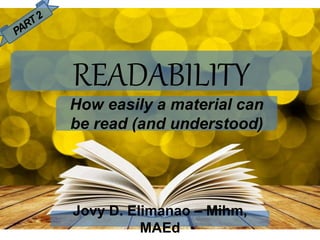
Readability (in literature) part 1
- 1. READABILITY How easily a material can be read (and understood) Jovy D. Elimanao – Mihm, MAEd
- 2. In Review: CRITERIA FOR SELECTION • Emotional Experience • Empathy • Craftsmanship • Values • Readability
- 3. In Review: CRITERIA FOR SELECTION • considerations when buying or reading a book: – Name of the author – Catchy title – Attractive book design – Thinness/thickness of the book – Size of the print – Blurbs on the outside – Subject matter – Writer’s style – Friend’s recommendation – Number of illustrations – Price
- 4. THREE GENERAL FACTORS THAT AFFECT READABILITY • The material • The Reader • The Purpose
- 5. The Material • Four general factors to consider in the material itself Content Format Organization theme kind / type of printing title of the book nature of subject matter illustrations chapter division unity of content general appearance paragraph divisions size , binding introductory notes number of pages study helps margins reference guides length of the lines glossary
- 6. The Material Writer’s style • Number of polysyllabic words – The longer the words, the less readable it is) • The number of unfamiliar words – Based on list of service words • Sentence length • Paragraph length
- 7. Computing for readability Flesch Grade Level Readability Formula • Step 1: Calculate the average number of words used per sentence. • Step 2: Calculate the average number of syllables per word. • Step 3: Multiply the average number of words by 0.39 and add it to the average number of syllables per word multiplied by 11.8. • Step 4: Subtract 15.59 from the result.
- 8. Computing for readability The specific mathematical formula is: FKRA = (0.39 x ASL) + (11.8 x ASW) - 15.59 Where, FKRA = Flesch-Kincaid Reading Age ASL = Average Sentence Length (i.e., the number of words divided by the number of sentences) ASW = Average number of Syllable per Word (i.e., the number of syllables divided by the number of words)
- 9. Computing for readability • Analyzing the results is a simple exercise. • For instance, a score of 5.0 indicates a grade-school level; i.e., a score of 9.3 means that a ninth grader would be able to read the document. • This score makes it easier for teachers, parents, librarians, and others to judge the readability level of various books and texts for the students.
- 10. The Reader Sub-factors to consider regarding your reader • Background • Chronological age / sex • Mental age / intelligence • Curriculum level • Reading ability / grade • Reader’s interests
- 11. The Reader Before selecting a specific passage or story for the class, the teacher should ask the following questions: 1. Although the topic is familiar, will I have to explain the setting which is not familiar to my pupils? (background) 2. Will I have to remove a lot of difficult vocabulary? (reading level, style, curriculum level)
- 12. The Reader 3. Will both the boys and the girls like the story? (interest, age, sex) 4. Can I read it straight from the book or do I “storybook” so that they have less difficulty in following the narrative? (organization) 5. Are the pictures big enough to be seen well by a class of 50? Do I need to have bigger pictures of the most crucial parts? (illustration, format)
- 13. The Purpose for Reading• We read for information and for entertainment For Information For Entertainment Book’s organizational features like glossaries and subtitles Puts emphasis on the importance of interest, background, and style Finds summaries and chapter introductions useful for study purpose
- 15. POETRY • First brush of literature for children – Lullabies – Verses – Chants – Tongue twisters • Love the funny sounds more than what they mean • Nonsense humor is enjoyable
- 16. Factors that teachers should consider: • The most popular contents of poetry for children are humor and familiar experiences • A poem enjoyed in Grade 1 may also be enjoyed by some other levels • Children do not like poems they cannot understand
- 17. Factors that teachers should consider: • Literary merit is not always a guarantee that poems will be liked • Children do not like meditative, thoughtful poems • Children prefer “new” poems to more traditional ones • Girls tend to like poetry more
- 18. Factors that teachers should consider: • Aside from humor, children love actions • They prefer a variety of subject matter • They do not like poems with long, descriptive passages • They do not like poems that have unfamiliar figures of speech or archaic language
- 19. Factors that teachers should consider: • They do not like pedantic-sounding poems • Continue from page 132
